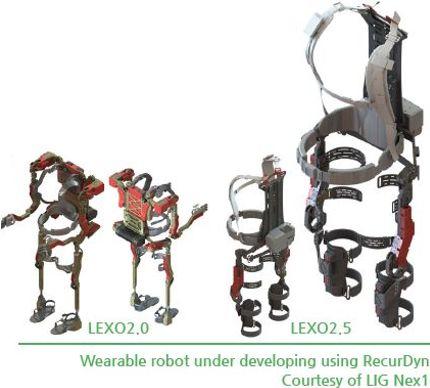{{ post.title }}
글 편집
글 편집 (이전 에디터)
{{ post.author.name }}
Posted on
| Version | {{ post.target_version }} | Product |
{{ product.name }}
|
|---|---|---|---|
| Tutorial/Manual | {{ post.tutorial.upload_filename }} | Attached File | {{ post.file.upload_filename }} |
Analysis Based on Human Body Modeling and Wearble Robot Design
ㆍProduct:
Wearable Robot
ㆍAnalysis Goal: Establishment of a dynamic model of human body and wearble robot for checking the range of motion of the designed product and verifying the control model
Download PDF File about Wearble Robot Design (Click)
Establishing a dynamic model of human body is essential in order to design dynamic model of wearable robot that a human can actually wear. Also, whether the wearble robot can take all the necessary postures in various situations must be checked.
This is done by estimating necessary torques of robot actuators according to the human body movements after attaching the wearable robot to the human body model and by checking the ROM (Range of Motion) of each joint.
Lastly, the performance of the controller must be checked by co-simulation of the actuator control model and the dynamic model of wearable robot.
Process for Wearable Robot Simulation
① Acquisition of human body motion data, creation of the human body model through a human body program called 'Bio-motion', and inputting of motion data
② Implementation of a dynamic model after importing the previously generated human body model to RecurDyn
③ Attaching a wearable robot to a human body using bushings and execution of dynamic analysis (simulation) of the human body movements → Acquisition of motion results of the wearable robot
④ Dynamic analysis after inputting of Ground Reaction Force (GRF) and the motion data of the wearable robot
⑤ Acquisition of required torque data of the wearable robot actuator and the range of motion (ROM) of the robot joints
⑥ Building a control model linkage using displacement and speed data of the actuator of the wearable robot and conducting co-simulation
Creation of Human Body Model for Wearable Robot Simulation
Key Technologies for Wearable Robot Analysis
ㆍ Creation of a dynamic model of human body using RecurDyn and Bio-motion
ㆍ Attachment of a wearable robot to a human body with a strap and dynamic modeling of the wearable robot
ㆍ Customization through ProcessNet in order for the post-processing of dynamic result and the application of various human body motion measurement data
ㆍ Co-simulation of the dynamic model and Simulink control model
Toolkits for Wearable Robot Simulation
ㆍRecurDyn/Professional
ㆍRecurDyn x Simulink Co-simulation (RecurDyn/Control) or CoLink
ㆍProcessNet
Customer Challenges
• Repair cost for product breakage during test process which is dicult to predict in the early stage
• Risk to a person wearing the prototype
• Excessive time and cost to repeat test processes every time the design changes (layout, actuator capacity, range of motion)
• Need for validation of wearable robot using various physical appearance of human body model
Solutions for Effective Wearable Robot Design
• Dynamic model creation including human body model to validate load torque of each joint
• Simulation using realistic and various human body models
• Cost reduction for prototype manufacturing through virtual validation of actuator capacity and range of motion

Outcomes
ㆍAfter a human model ‘which takes into consideration the torque actuator that is loaded on each joint’ was brought to RecurDyn, a dynamic model was established
ㆍThe torque and motion range of joints required in a wearable robot for each assigned motion can be estimated; proposed the motion range of actuator based on this estimation
Other Applications Related to Wearable Robot Simulation
◀
Analysis of a robot that can climb stairs
ㆍDesign of a controller in order to prevent a robot from falling down
ㆍDetermination of motor capacity required to operate a robot


(This technology is often used for various kinds of robot simulation)






